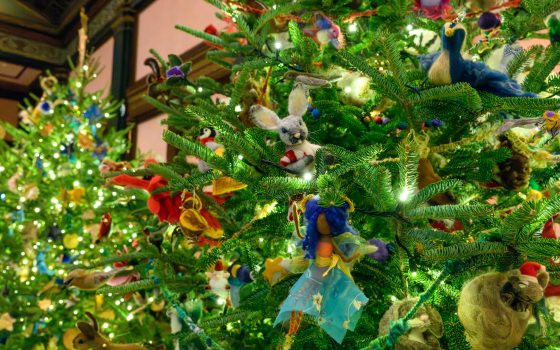When it comes to our Conservatory seasonal displays, every single plant, every single color, every single texture—every single detail, really—is by design. About a year prior to each season, our horticulture staff and our display designer start planning how to interpret that season’s theme or desired look through plants, giving ourselves ample time to not only grow or acquire those plants, but also determine how best to approach the overall design. Typically we take a formal and symmetrical approach to our design, as symmetry is easy for the eye to interpret and appreciate. This summer, however, we’ve decided to take an entirely new approach. Through a bevy of tropical plants, palms, and Longwood favorites, we’ve planted our Conservatory in an asymmetrical design that encourages guests to slow down, look, and think a lot more about the nuances of the design.
This summer’s Conservatory planning design was inspired by a recent trip to Hawaii—specifically a path of asymmetrical bromeliads that provided a variety of colors and textures. We started off thinking that we would apply the asymmetrical approach to just one of our nine Main Conservatory walkways, but that concept quickly grew into a design for the entire Main Conservatory—and as an opportunity for our team to think about the summer seasonal display in an entirely new and challenging way. While there is so much asymmetry in nature, it’s a challenge to plant this way in the Conservatory because there is so much symmetry in the Conservatory’s architecture itself.
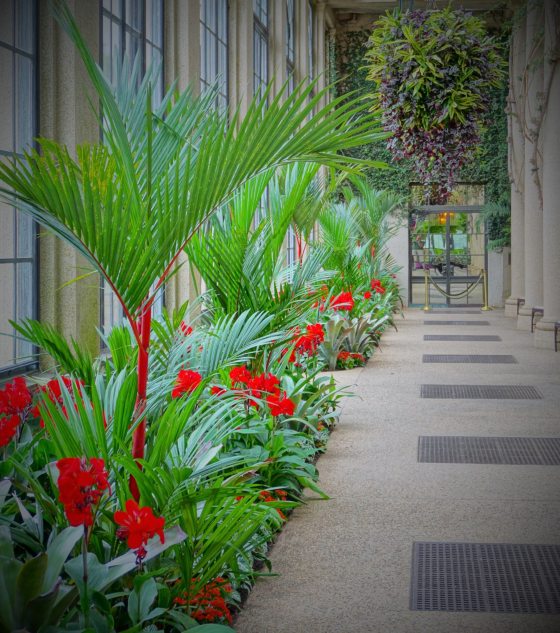
Cyrtostachys renda, shown here in our Exhibition Hall, is sometimes called lipstick palm because of its bright red crownshaft. Here, it’s complemented by the striking red Canna ‘Brandywine’. Photo by Karl Gercens.
Typically, our Conservatory beds are planted in a formal, symmetrical plan. We often plant around columns in concentric circles. The back of the beds between the columns—which we call hyphens—are planted in straight lines. The front of the beds—which we call ribbons—are also planted in a symmetrical fashion. We typically use only three types of plants in each vignette of varying heights—one tall, one medium, one short. All of these lines combine to achieve a balanced look that the eye is trained to appreciate at very quick glance. When you look down the walkway the design is beautiful and simple to interpret. One might also imagine there’s no need to venture farther since you see it all in one spot.
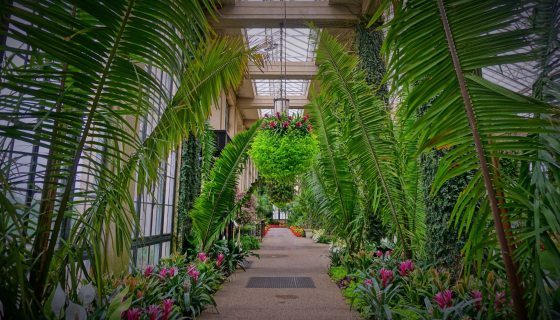
Dramatic Attalea cohune lead the way along the southeast walkway of the Conservatory. Photo by Karl Gercens.
To achieve this summer’s asymmetrical effect, we’re using sometimes up to five plants of differing heights in a visually balanced, yet not actually balanced, way in each of our design vignettes. Of the up to five plants in each vignette, the larger plants create a substory and serve as a visual outer shell, helping to offset the more formal architecture of the space itself. You might see one plant on the left and three on the right. As you venture along the walkway take note of the number of large plants on each side; it’s different in each section! The overall effect from the starting point looks more balanced than it is. This is the beauty of asymmetrical design. It can be very complex up close, but still soothing from a distance.
Each of the nine walkways in the Main Conservatory is its own moment and highlights a specific palm or two—and each of the palms holds horticultural significance and obvious beauty, from bold red hues to feathery or fluffy fronds. For our palm species, we purchased the most outstanding specimens commercially available from Florida; each is robust and loves the summer here. Palms have fibrous root systems and can be grown in small pots relative to their size, so they are amenable to shipping. Installation of the palms itself is straightforward as well, as many arrived in felt bags and can be planted that way. Caring for the palms is easy for the summer, we’ll just remove older fronds as they yellow—and since there is little wind in the Conservatory, they don’t require any additional support.
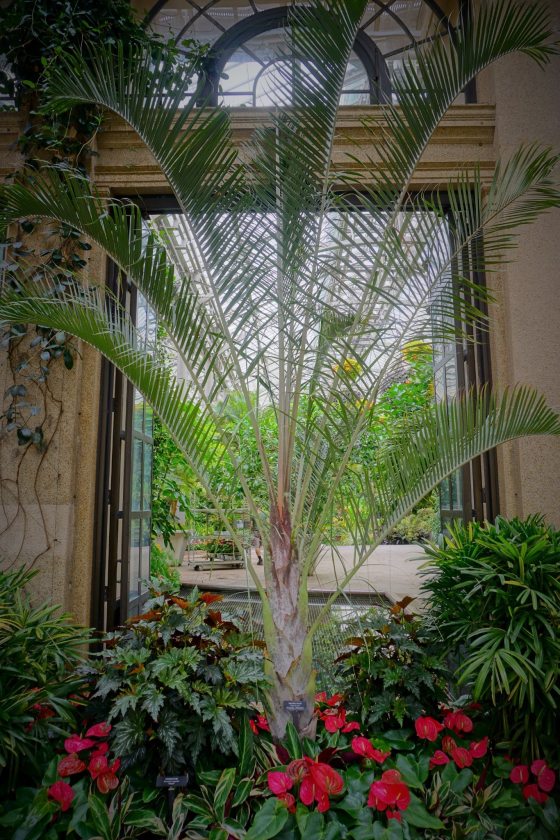
Dypsis decaryi features a triangular base, which gives rise to the common name of triangle palm. Photo by Karl Gercens.
Palms have so much to offer when it comes to display design. The architectural form of each palm allows for negative space above the underplantings, which helps to drive home our asymmetrical design. The Verschaffeltia splendida on the center walk of the Orangery is one of the most interesting selections we have this year. It’s a monotypic genus and occurs on only three islands in the Seychelles. The visible stilt roots are quite the conversation piece while the unsplit leaves are certainly eye-catching! The Attalea cohune on the southeast Orangery walkway form an archway when approaching from the elevator looking towards the Indoor Children’s Garden. The narrow stems of the Ptychosperma macarthurii on the southwest Orangery walkway are so elegant and contrast beautifully with the bold Bismarckia nobilis on the west walkway.

The calm silver sheen of Bismarckia nobilis complements any color palette; we selected it for a smaller walkway in the Conservatory to help showcase its large size. Photo by Karl Gercens.
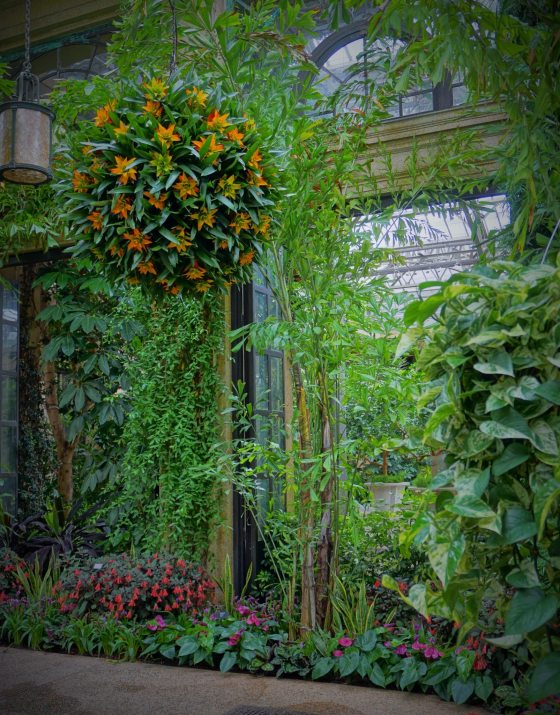
What’s more, the palms add height to the display. You’ll see the height on the northeast Orangery walkway where the Caryota mitis (fishtail palm) are almost scraping the ceiling. This beautiful palm has bipinnately compound leaves which is quite unusual for this family! All these palms have medium and short underplantings designed to be very free form, informal, and asymmetric. Photo by Karl Gercens.
Anchored by our palms, each walkway features multiple vistas and vignettes bursting with Longwood crops you know and love—plants such as Canna, Fuchsia, and Begonia—as well as tropicals like golden Sansevieria, Alocasia, striped Aechmea, and black Anthurium. While each palm will stay at its associated walkway, we will swap out other plants throughout the season, and our walkways’ color palettes will change and shift. Therein lies the true joy of the Conservatory—the ability to rotate our plantings, so the space is like a huge vase of cut flowers, always at the peak of perfection. And while there will be color from the flowers, there will also be an abundance of color from the foliage itself—and the beauty of the foliage will persist throughout the entire season.
In addition to asymmetry, we’re playing with reverse forced perspective, in which objects farther away from the viewing plane appear larger while closer objects appear smaller—this is a direct contrast to the more conventional linear perspective in which closer objects appear larger. You’ll see this on the north and south walkways of the Orangery. The four corners have huge baskets of Guzmania while the two baskets closer to the center of the room are much smaller.
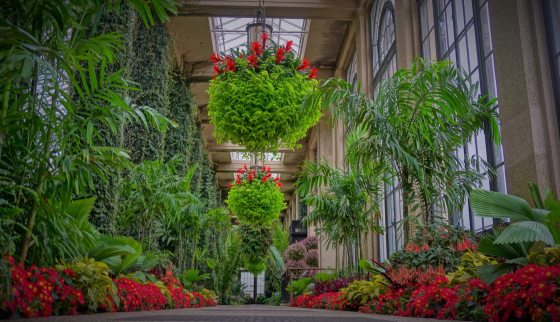
The southwest walkway of the Orangery boasts Guzmania baskets from end to end. Photo by Karl Gercens.
We’re also using plants in extraordinary and unexpected ways in this display. For example, we typically use Philodendron as a groundcover. This summer, however, we’re using 4-foot-tall Philodendron ‘Red Emerald’ totems to provide height, or exclamation points, to the beds. You’ll see in the northwest Orangery we have Dracaena ‘White Bird’ that is trained in a cloud-form. A bare stem gives rise to a “poof” on top that is seemingly floating above the rest of the plants.
We are delighted to share our new summer display with you, and encourage you to experience it again and again, as our colors shift, our textures delight, and our asymmetrical approach encourages you to slow down and take a longer look.


